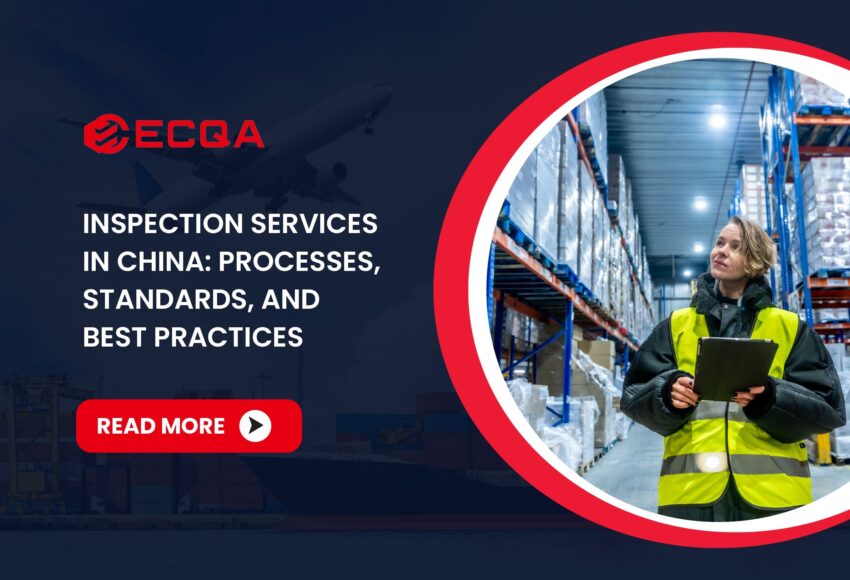
Inspection Services in China: Processes, Standards, and Best Practices
Inspection services in China are widely used by importers to verify product quality, confirm specifications, and support compliance with regulatory requirements. These inspections provide an independent evaluation of workmanship, materials, labeling, and performance before goods are shipped. Third-party inspection in China forms an essential part of supply-chain quality control by offering structured assessment methods and clear reporting that help buyers make informed decisions.

This article explains the key processes involved in inspection services in China, the standards commonly referenced, the steps inspectors follow on-site, and the operational considerations buyers should understand when working with China factories.
What Third-Party Inspection Means
Third-party inspection refers to an independent assessment of manufactured goods carried out by a neutral inspection company. Inspectors compare finished or in-process products with the buyer’s documented requirements and report any deviations.
Key Characteristics
• The inspector is independent from both supplier and buyer.
• Evaluations follow agreed specifications, drawings, purchase orders, and quality guidelines.
• Reports include photographs, measurements, and defect records.
• Inspections can be performed at different stages of production.
Why It Is Used in China
China’s manufacturing landscape includes factories of different sizes and quality-control capabilities. Independent inspections help importers manage variability, evaluate compliance with international standards, and maintain transparency across production processes.
When Inspections Are Needed in China
Inspection timing depends on product type, production risk, and buyer requirements.
1. Pre-Production Inspection (PPI)
Purpose: confirm raw materials, components, and factory readiness.
Checks include:
• raw material quality
• machinery and tooling setup
• first article sample
• production planning and timeline
2. During Production Inspection (DUPRO)
Purpose: evaluate semi-finished goods during manufacturing.
Checks include:
• in-process products
• production consistency
• packaging materials
• early detection of workmanship issues
3. Pre-Shipment Inspection (Final Random Inspection)
Purpose: assess finished goods before shipment.
Checks include:
• visual appearance
• functionality
• measurements
• labeling and packaging
• AQL sampling based on batch size
4. Container Loading Supervision (CLS)
Purpose: ensure accurate loading and proper handling.
Checks include:
• SKU and carton quantity
• container interior condition
• sealing of the container
• loading photographs for documentation
Inspection Standards and Reference Frameworks
Inspection services in China follow recognized international standards and buyer-specific requirements. Chinese regulations may also apply depending on the product category.
1. AQL Sampling (ISO 2859)
The Acceptable Quality Limit (AQL) system defines sample sizes and acceptable defect thresholds using statistical methods.
References:
• ISO 2859 series
• ANSI/ASQ Z1.4
• MIL-STD-105E (historical reference)
Common levels include General Level II for standard consumer goods and Special Levels S1–S4 for smaller or critical items.
2. Technical Standards Often Used
Inspectors verify performance, safety, and material requirements against relevant standards such as:
• ASTM for mechanical and material properties
• IEC for electrical safety
• ISO for general quality specifications
• EN standards for European markets
• GB/T standards for Chinese domestic requirements
3. Compliance-Related Standards
Certain product categories must meet regulatory requirements including:
• CE marking
• RoHS
• REACH
• FCC requirements
• Food-contact material regulations
• Toy safety standards EN 71 and ASTM F963
• Medical device standards based on classification
Inspectors review labels, markings, user instructions, and available test reports to support compliance verification.
How to conduct inspection in China
1. Booking and Preparation
• Buyer provides specifications, drawings, photos, PO, and inspection checklist.
• Inspection company confirms the visit with the supplier.
• Inspectors prepare tools such as calipers, cameras, barcode scanners, and simple test devices.
2. On-Site Verification
• factory introduction and confirmation of production status
• verification of total quantity produced
• random sampling following AQL
• isolation of selected samples
3. Inspection Activities
• workmanship assessment
• measurement verification
• functional performance tests
• material checks
• labeling and barcode verification
• packaging and carton quality
• carton drop tests where applicable
4. Non-Conformity Categorization
Defects are classified as:
• critical
• major
• minor
The acceptable quantity depends on the AQL table.
5. Reporting
Inspection reports include:
• photo documentation
• measurement results
• defect list
• compliance status
• pass, fail, or pending evaluation
These findings help buyers decide whether to approve shipment or request corrective action.
How Third-Party Inspectors Operate in China
Independence
Inspectors do not influence production decisions. Their role is to evaluate and report objectively.
Standardized Procedures
Most inspection service providers use structured checklists aligned with international standards, ensuring consistent evaluations across regions and factories.
Local Knowledge
Inspectors familiar with Chinese manufacturing practices recognize recurring issues and common risk areas in different product categories.
Communication Protocols
Information is communicated through:
• onsite verbal summaries
• photographic records
• written inspection reports
• follow-up recommendations where needed
Benefits of Third-Party Inspection for Supply Chain Stability
1. Early Detection of Defects
Inspections identify issues before shipment, reducing the risk of returns, rework, or customer complaints.
2. Improved Supplier Accountability
Regular evaluations encourage suppliers to follow agreed quality standards and maintain consistent production conditions.
3. Evidence-Based Decision-Making
Reports provide objective data such as measurements, photos, and defect counts. Buyers rely on this information when approving shipments.
4. Risk Management
Independent review supports the management of operational and regulatory risks across international supply chains.
5. Cost Efficiency
Inspections help avoid losses associated with:
• non-conforming products
• rejected shipments
• transportation damage
• product failures in the market
Selecting a reliable inspection service provider influences inspection accuracy and overall quality-control effectiveness.
Read here: How to Choose the Right Third-Party Inspection Company
Inspection services in China play an important role in supporting global sourcing activities. Third-party inspections help importers verify quality, identify defects, confirm labeling, and evaluate compliance with international standards. Standardized processes and structured reporting support clear communication between buyers and manufacturers. By understanding inspection workflows, standards, and best practices, businesses can manage quality risks more effectively and improve long-term supply-chain performance.

 Request Free Sample Report
Request Free Sample Report